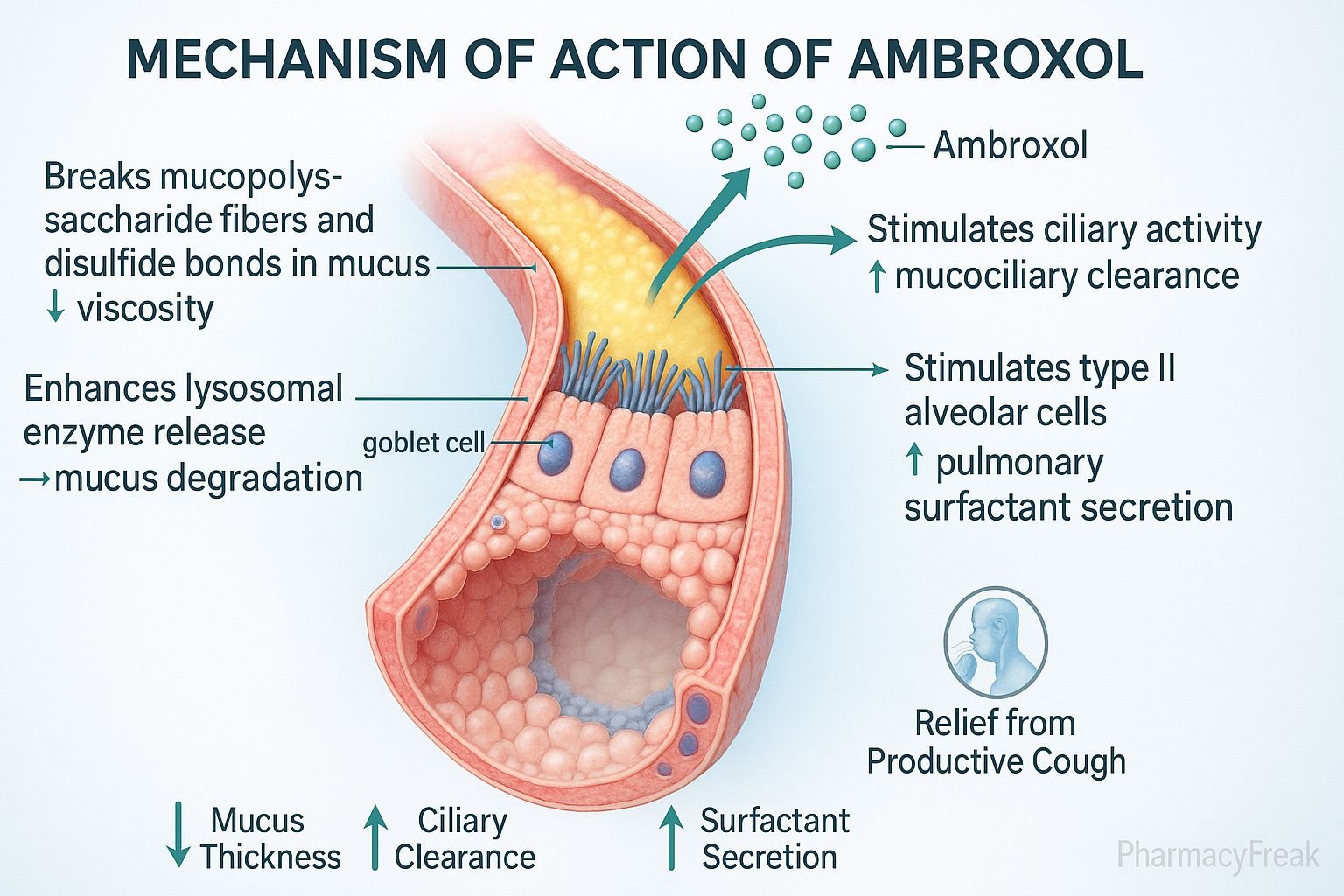Table of Contents
Introduction
Ambroxol is a mucolytic and expectorant agent widely used in the treatment of respiratory tract disorders associated with excessive or viscous mucus, such as bronchitis, COPD, and asthma. Mechanism of Action of Ambroxol involves enhancing mucus clearance, stimulating surfactant production, and improving mucociliary transport. It not only facilitates expectoration but also exerts anti-inflammatory and local anesthetic effects, making it a key component of modern respiratory pharmacotherapy.
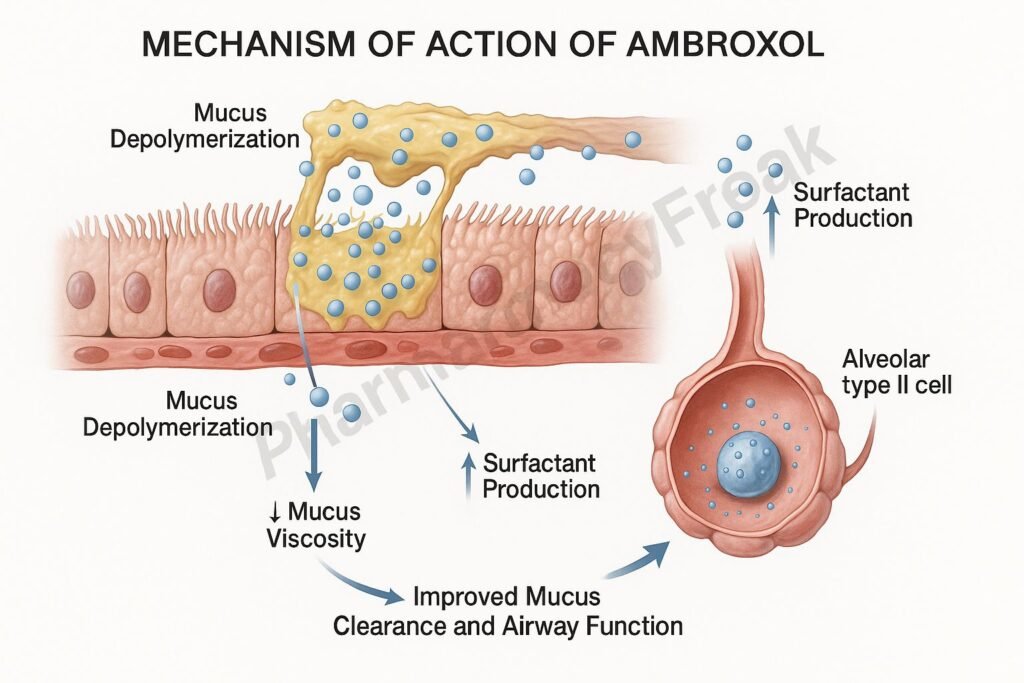
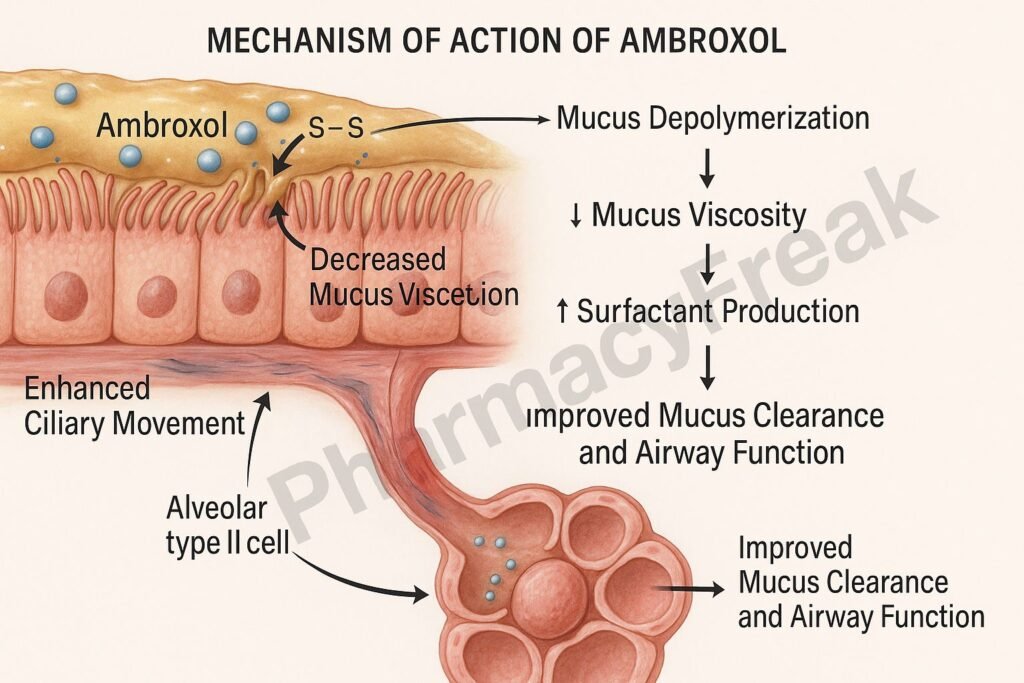
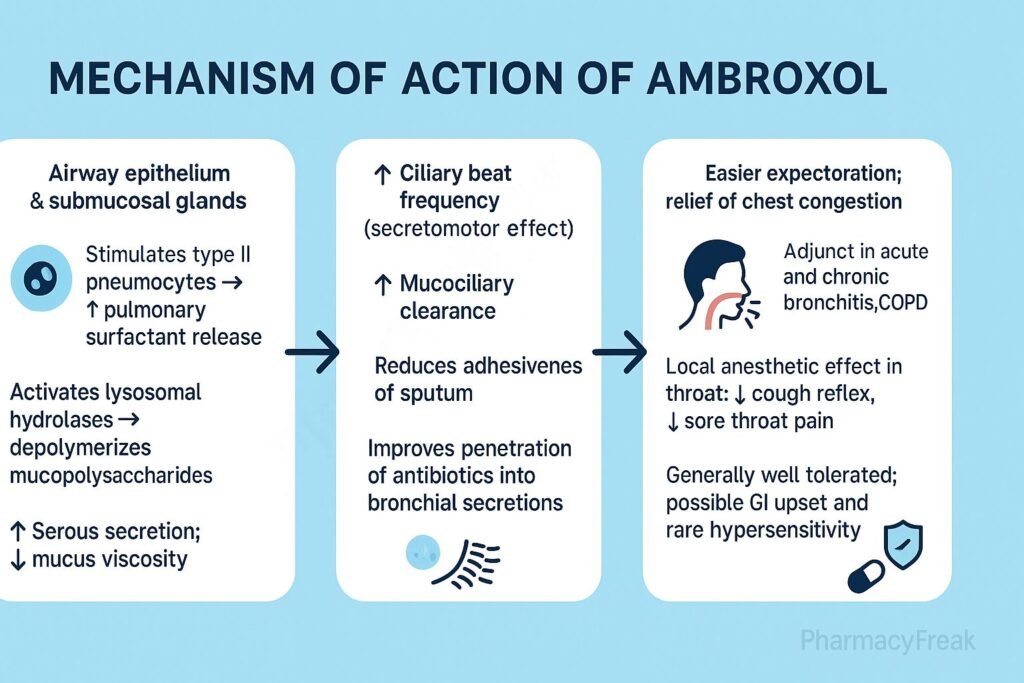
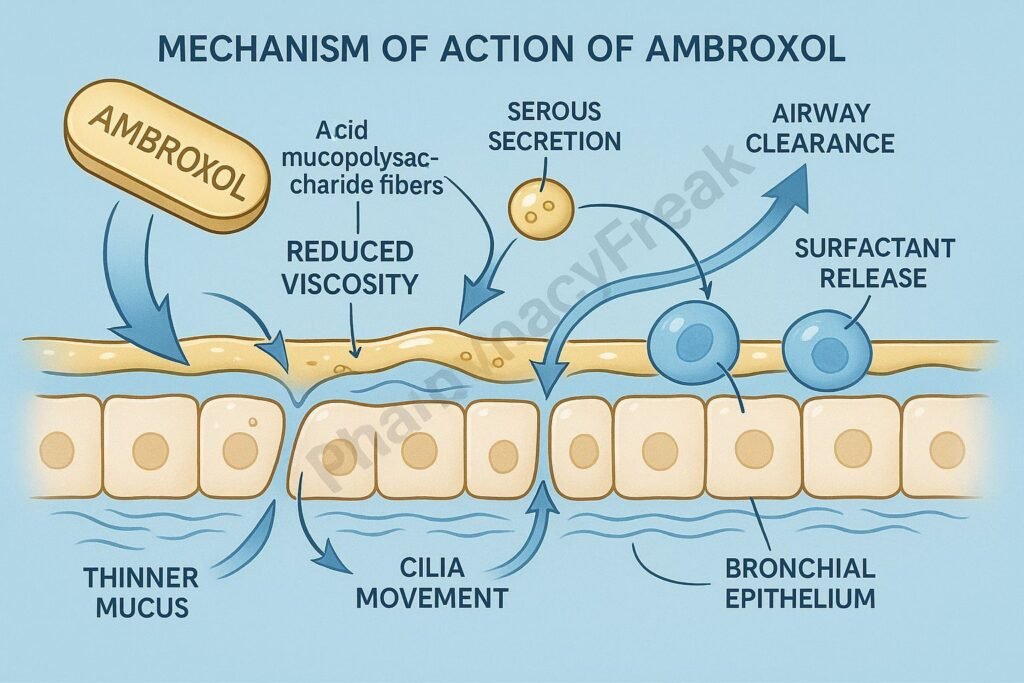
Mechanism of Action (Step-wise)
- Mucolytic Action (Breaking Down Mucus)
- Ambroxol acts on the mucus structure by depolymerizing mucopolysaccharide fibers and breaking disulfide bonds, leading to a reduction in mucus viscosity.
- This results in thinner, less sticky mucus that is easier to cough out.
- Stimulation of Surfactant Production
- Ambroxol stimulates type II pneumocytes in the alveoli to produce pulmonary surfactant.
- Surfactant reduces mucus adhesion to bronchial walls, facilitating mucus transport and preventing airway collapse.
- Enhancement of Mucociliary Clearance
- By increasing ciliary beat frequency, ambroxol enhances mucociliary transport, accelerating the clearance of mucus and trapped pathogens from the respiratory tract.
- Anti-Inflammatory and Antioxidant Effects
- Ambroxol inhibits pro-inflammatory cytokines like IL-1β and TNF-α.
- It also scavenges free radicals, protecting respiratory tissues from oxidative stress.
- Local Anesthetic Effect
- Ambroxol blocks sodium channels in sensory neurons, providing soothing relief from sore throat and cough irritation.
- Overall Effect
- ↓ Mucus viscosity + ↑ Surfactant + ↑ Ciliary activity = Enhanced airway clearance
- Leads to easier breathing, improved sputum expectoration, and better oxygenation.
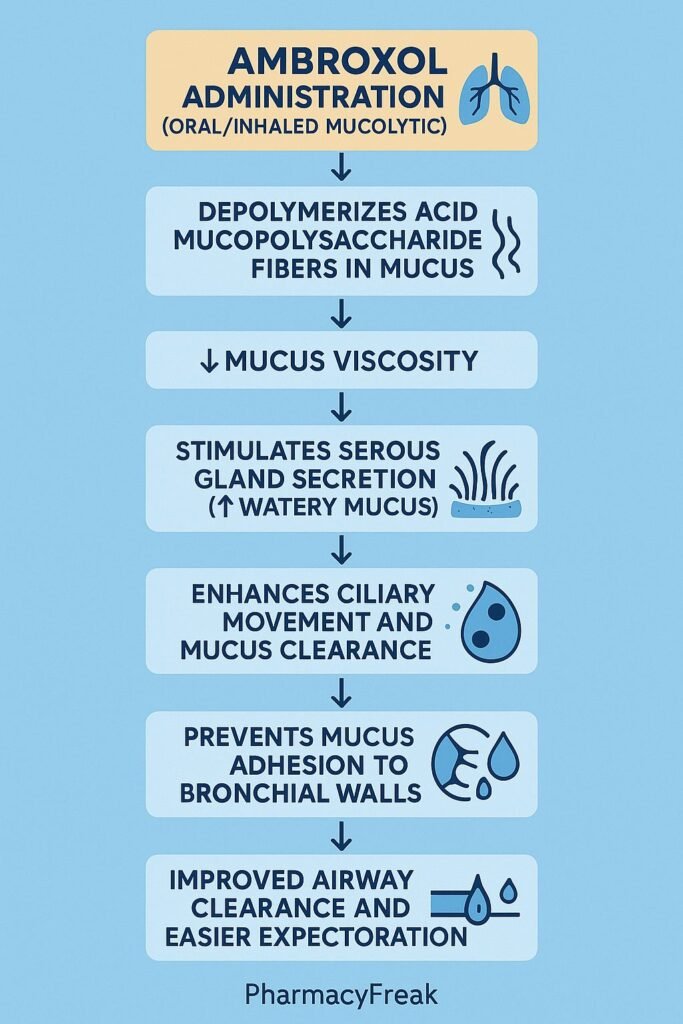
Pharmacokinetics
- Absorption: Rapid after oral administration; bioavailability ~70%.
- Distribution: High concentration in lungs and bronchial tissue.
- Metabolism: Hepatic metabolism to inactive metabolites (via CYP3A4).
- Excretion: Primarily renal; ~85% as metabolites.
- Half-life: 8–12 hours (prolonged in severe liver disease).
Clinical Uses
- Acute and chronic bronchitis
- Chronic obstructive pulmonary disease (COPD)
- Bronchial asthma (as adjunct therapy)
- Respiratory infections with thick sputum
- Postoperative pulmonary care to enhance mucus clearance
- Pharyngitis or sore throat (as lozenges due to local anesthetic effect)
Adverse Effects
- Common: Nausea, vomiting, mild gastric discomfort.
- Occasional: Diarrhea, dry mouth, headache.
- Rare: Skin rash, urticaria, hypersensitivity.
- Severe (very rare): Stevens–Johnson syndrome, anaphylaxis.
- Contraindications: History of hypersensitivity, peptic ulcer, severe hepatic or renal impairment (use cautiously).
Comparative Analysis
| Feature | Ambroxol | Bromhexine | Acetylcysteine |
|---|---|---|---|
| Mechanism | Mucolytic + surfactant stimulator | Mucolytic (prodrug of ambroxol) | Breaks disulfide bonds |
| Onset of action | Fast (within 30–60 min) | Slower (requires metabolism) | Moderate (systemic) |
| Surfactant stimulation | Yes | Weak | No |
| Local anesthetic property | Present | Absent | Absent |
| Anti-inflammatory property | Moderate | Mild | Mild |
MCQs
1. Ambroxol belongs to which class of drugs?
a) Antihistamines
b) Mucolytics
c) Bronchodilators
d) Antitussives
Answer: b) Mucolytics
2. The main mechanism of ambroxol is to:
a) Dilate bronchial muscles
b) Reduce mucus viscosity and enhance clearance
c) Block histamine receptors
d) Stimulate adrenergic receptors
Answer: b) Reduce mucus viscosity and enhance clearance
3. Ambroxol increases the production of:
a) Surfactant
b) Histamine
c) Acetylcholine
d) Serotonin
Answer: a) Surfactant
4. Which cell type is stimulated by ambroxol in the lungs?
a) Type I pneumocytes
b) Type II pneumocytes
c) Goblet cells
d) Macrophages
Answer: b) Type II pneumocytes
5. Ambroxol exerts local anesthetic action by blocking:
a) Calcium channels
b) Potassium channels
c) Sodium channels
d) Chloride channels
Answer: c) Sodium channels
6. Ambroxol is a metabolite of:
a) Bromhexine
b) Acetylcysteine
c) Carbocisteine
d) Guaifenesin
Answer: a) Bromhexine
7. Which of the following effects is NOT associated with ambroxol?
a) Surfactant stimulation
b) Mucociliary clearance improvement
c) Histamine release
d) Anti-inflammatory effect
Answer: c) Histamine release
8. Common adverse effect of ambroxol is:
a) Drowsiness
b) Gastric irritation
c) Bradycardia
d) Hypertension
Answer: b) Gastric irritation
9. Ambroxol should be used cautiously in:
a) Hepatic impairment
b) Glaucoma
c) Diabetes
d) Anemia
Answer: a) Hepatic impairment
10. Ambroxol helps in productive cough by:
a) Suppressing cough center
b) Increasing mucus viscosity
c) Facilitating mucus expectoration
d) Causing bronchospasm
Answer: c) Facilitating mucus expectoration
FAQs
Q1. How does ambroxol work as a mucolytic?
It breaks disulfide bonds in mucus, reducing its viscosity and improving clearance.
Q2. Does ambroxol help in dry cough?
No, it is mainly useful for productive cough with thick sputum.
Q3. Is ambroxol safe in children?
Yes, it can be used in pediatric doses under medical supervision.
Q4. How is ambroxol different from bromhexine?
Bromhexine is a prodrug of ambroxol; ambroxol acts faster and has additional surfactant-stimulating properties.
Q5. Can ambroxol cause allergic reactions?
Rarely, it may cause rash or hypersensitivity; discontinue use if such reactions occur.
Q6. Is ambroxol available as a combination drug?
Yes, often combined with salbutamol, guaifenesin, or levocetirizine for cough and cold relief.
References
- Goodman & Gilman’s The Pharmacological Basis of Therapeutics
- Katzung’s Basic and Clinical Pharmacology
- Harrison’s Principles of Internal Medicine
- European Respiratory Society Guidelines on Mucolytic Therapy
Related Internal Links

I am pursuing MBA in pharmaceutical management from NIPER Hyderabad with a strong academic record and proven success in national-level pharmacy entrance exams. I secured AIR 61 in NIPER 2024 (MS/M.Pharm) and AIR 27 in NIPER MBA, along with AIR 147 in GPAT 2024 and AIR 907 in GPAT 2023. I also achieved AIR 6 in AIIMS CRE-2025 for Drug Store Keeper and was selected as a Pharmacist (AIR 61) for ESIC. Additionally, I was the Runner-Up in Round 2 of the EY Case Study Competition.
At PharmacyFreak.com, I aim to guide future pharmacists through expert content, exam strategies, and insightful resources based on real experience and academic excellence.
Mail- harsh@pharmacyfreak.com
